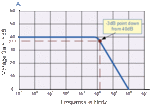preethi19
Full Member level 5
Hi could anyone pls explain to me how to do the ac analysis for four quadrant multiplier. I took the DC and transient analysis and verified the functionality. The dynamic input range is between -350nA to 350nA. When i plot the transient analysis i am getting a the output signal amplitude in accordance to the circuit functonality say around 250nA. Inorder to find the system's frequency response i did ac analysis. I replaced the DC input current source with isin source. And set the AC magnitude to 350nA (becoz the input range is from -350 to 350 so i am assuming that this is the value that should be set for magnitude) After all i saw AC magnitude is just used to represent the current. Pls correct me if i am wrong here. But when i run the AC analysis i just get a signal like

I know that in frequency domain the frequencies where the system can operate will be shown. And in time domain with respct to time like
Suppose say from 1st fig we say the range of the signal where it goes high to low is the system's frequency range but then be it time or freq domain the amplitude of the signal remains the same. But say in transient if i get around 250nA i should get same for AC analysis too.. But the maximum peak that the amplitude is going is to 40nA. I have two input current sources for the two mulitplier parameters i1 and i2.. And set the AC magnitude of both to 350nA. So pls let me know where i am going wrong becoz i think i am missing on somehwre. WOuld be great if anyone can help... thank you!!!

I know that in frequency domain the frequencies where the system can operate will be shown. And in time domain with respct to time like

Suppose say from 1st fig we say the range of the signal where it goes high to low is the system's frequency range but then be it time or freq domain the amplitude of the signal remains the same. But say in transient if i get around 250nA i should get same for AC analysis too.. But the maximum peak that the amplitude is going is to 40nA. I have two input current sources for the two mulitplier parameters i1 and i2.. And set the AC magnitude of both to 350nA. So pls let me know where i am going wrong becoz i think i am missing on somehwre. WOuld be great if anyone can help... thank you!!!


